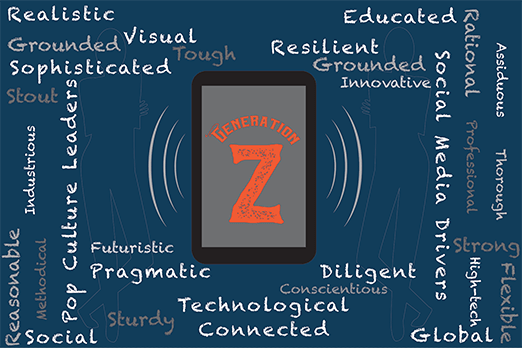Like many of you in retail and brand marketing, I have spent the last few decades researching innovative ways to target everyone from baby boomers, to Gen X, and then millennials. In retail, it is far more than just the marketing that has had to change. We’ve had to embrace the need for omnichannel customer service and understand each generation’s new expectations of products.
According to FutureCast, Millennials now represent $1 trillion in buying power—and that does not even include the fact that they are also very influential with their parents. This is especially true when it comes to any buying decisions relating to technology, as they are usually their parents’ tech support. Millennials are now between 20 and 35-years-old and many are getting into their top producing years. They now command enough experience and income to set trends across retail, not only through purchasing, but also in roles where they’re the ones making decisions about products, brand marketing, and retail in general. In fact, most of the retail workforce is also made up of millennials.
But what comes after millennials? Say hello to Generation Z: born after 1996. Currently, the oldest group of Gen Z is in college or entry-level positions of the workforce now, with the rest running down into teenagers and younger. They already represent $44 billion in discretionary spending and you will find that they are an interesting blend of the traditional and the nonconformist. I happen to know a bit about this group given that I have three myself. My oldest was born in 1996 and my youngest in 1999—two sons and a daughter, in that order. As a result, I have become intimately aware of how different they are from my generation (Gen X), my parents (the boomers), or the millennials that we have been so focused on for the last 15 years or so.
So what makes Gen Z who they are? First off, it is important to note who they are not. They are not like millennials in many ways and it would be a mistake to market to them or sell to them like they are. Here are some key characteristics of Gen Z:
They’re more financially conservative.
Gen Z grew up in the recession, so they have seen what overspending and bad investments can do. Opinion polling shows that they have more in common with the “greatest generation” who grew up in the Great Depression, than boomers, Gen X, or millennials in this key area. They know the value of a dollar and want to make sure they’re getting it when they make a purchase. They also want to be thanked with customer loyalty rewards.
They value hard work and believe in creating their own opportunities.
They are hardworking, financially responsible, independent and determined to earn what they deserve. Surveys have shown that they value education, entrepreneurship, having a family and being financially savvy. They have seen a lot of hardship and failure in news media and in the financial lives of those around them. As a result, Gen Z sees it as their own job to solve their problems and brands are there to help them, not do it for them. This is a key distinction and change in how brands will need to market to this group.
They are much more liberal in their views—especially socially.
But not in the same ways millennials are. Where millennials were very environmentally conscious, Gen Z is not nearly as much. They see this more as an expectation or a given that technology should be low emission and energy efficient. They are much more focused on social equality. They have been raised in a time where most schools are more than 50 percent polyethnic and diverse. The concepts of gender, ethnicity, and sexual preference are much more fluid for them. They see these issues as black and white and will not be tolerant of those that are unaccepting of other people. They believe it’s time to move past old cultural hangups.
Authenticity is key with this generation.
Not only in holding brands responsible but also in how they see themselves. These teenagers see themselves as individuals that define who they are and feel free to be unique and different. We have even seen the natural (minimal makeup) trend with celebrities posting images of themselves on social media. As a result, personalization and customization will be something that will be important for brands. Making a product their own unique personification of that brand. Branding will need to be secondary and it will need to support personalization. When done correctly, brand marketing can create a lot of buzz and business very quickly, but if they do not stay on top of it and show they are for real, then they can quickly lose their footing. Two such examples are the recent Pepsi commercial (seen as tone-deaf and inauthentic) and United Airlines’s treatment of customers and their subsequent PR faux pas. Gen Z will not stay with a brand, just because they are a big brand. They will go just as quickly to a small brand, if they feel it can do what they need and supports their views.
They were raised with YouTube, iPods, iPhones, tablets, social media, and Google.
The days of amazing consumers with slightly updated tech features is over. Gen Z expects products to be truly cutting edge and to offer features that meet their actual needs. They also expect you to offer free, fast Wi-Fi in stores because they’re on smartphones, consulting web reviews and their social circles about purchases in real-time. They have been raised on social media and two-way communication, so they value brands that ask and actually listen. Brands that participate and market through social media need to be more on point for Gen Z. These teenagers are very conscious of their public personas and are very careful of what they do on social media – 75% of them have multiple online personalities between the social networks. They have their own set of rules for how to communicate, which platform to use for what and how. For instance, they use Facebook to passively scroll through what’s happening, they use Instagram to very carefully show the idealized version of things, they use Twitter to get real time information, and they use snapchat to share, through pictures, what’s happening now. Understanding how to connect with Gen Z using these platforms will be crucial to brands.
It is easy to lump the younger generations together and just think, “These kids today!” We have to accept that every generation is raised in different circumstances that impact brand marketing strategy. And those of us that work in retail day-to-day are already seeing some of these shifts in behavior. We will need to continue to seek to understand in order to be ready for this millennial to Gen Z brand marketing shift. It may be a bigger one than anyone imagined. Many of us will have tens of thousands of them working for us in the next few years and we certainly will have billions, if not trillions of dollars flowing from this group in the next five to 10. If we mislabel them as millennials, we miss the opportunity to connect and capitalize on these key differences.


